A Miguel by any other name
San Miguel's first town center rose near the present
railroad station -- today a busy place but far from
the center of life for the madding tourist and expat crowd
who favor the quaint Jardin.[2]
Not really a town but a primitive mud and
tree-branch "building" housing an altar, San Miguel was
started near the oft dry Laja river by an itinerant Spanish
Franciscan named Juan de San Miguel. Depending upon
whom you ask, the year was either 1538 or
1542.[2]
Although indigenous people had been in the area for
at least 2000 years, they had pretty much abandoned this
spot; the semi-nomadic
Chichimecca tribes such as the Purepechas
and Otomis had scattered to avoid the Spanish Invaders who
had been "saving" them for nearly two decades.
(Mexico had
its immigration problems then.)
Founding father Juan left shortly after in search of other
indigenous souls desperately seeking conversion. Very
quickly the "town" moved a few miles northeast to a spring
which could provide a more reliable source of water.
The place became known as
Itzcuinapan, the river of the
dogs. (More on that later when we discuss the
Chorro area).
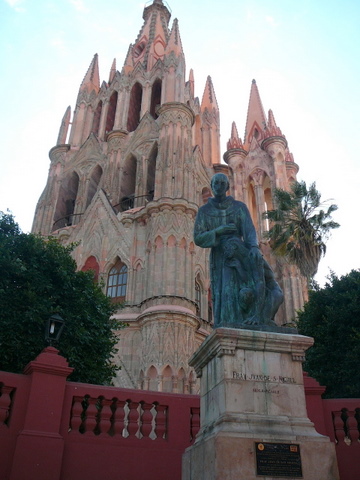 |
This photo shows a couple of
ironic icons watching over the present town center:
Fray Juan and the Parroquia. Juan de San Miguel
walked through much of central Mexico barefoot
with a shell stuck in his rope belt in order to have
a vessel to use in baptizing new Christians. He never
stayed anywhere very long, especially in this spot
that shares his name with that of native son Ignacio
Allende. La Parroquia, as symbolic of San
Miguel as the Eiffel Tower is of Paris, was created
by an illiterate architect thinking he was erecting a
high Gothic facade in this quintessential Spanish
Colonial town. (Much more about that later as
well). |
Conde Nast Travel Magazine readers consider San
Miguel to be the
5th best city in the Americas, but this is a fairly
recent evaluation. The Aztec Empire had never been
able to subdue the natives of this arid region and the
conquering Cortez specifically singled them out as
"barbarians that were less reasonable than people from the
other provinces."
[215]
Things have improved since; we found the
Miguelinos to be
quite pleasant, even the expats.
Soon the town became known as
San Miguel de los Chichimecas,
a bit ironically as the Spaniards were forced to move more
docile (and already somewhat "converted"
natives) from
Tlaxcala north to populate this area
.[4]
Within a decade of Fra Juan's founding of
Itzcuinapan, silver
mines in
Zacatecas started pouring out the raw materials for
what would become the coin of the largest empire in the
world: the Spanish pieces of eight (the original
eight bits for you
computer geeks). But before silver could be turned
into power, it had to
be transported through hostile
Chichimeca territory.
Therefore the Spaniards built a series of stopover towns
about one-days journey apart.
By 1555 this humble stopover had been upgraded to a
village named San Miguel el Grande (the Great) by Viceroy
Don Luis de Velasco.
[233]
Soon modest baroque stone replaced mud and sticks and
in the 17th century the town center moved to its present
location about a half-mile north of the springs.
[2]
The eighteenth century sees a prosperous San Miguel
earning its el Grande name as its grows in wisdom, grace,
buildings, commerce, and education. It also sees the
birth of Ignacio José
de
Allende
y Unzaga who will give his life for Mexican
independence. In turn, Mexico gave his name to the
town. The name San Miguel de Allende has stuck
since 1826.
The Churches of San Miguel
This place is laden with history, some of which we'll
cover later. Now let's talk about some of San
Miguel's many churches (close to
300+ say some sources)
Because of its location just off the main square and its
iconic status, La Parroquia gets the most
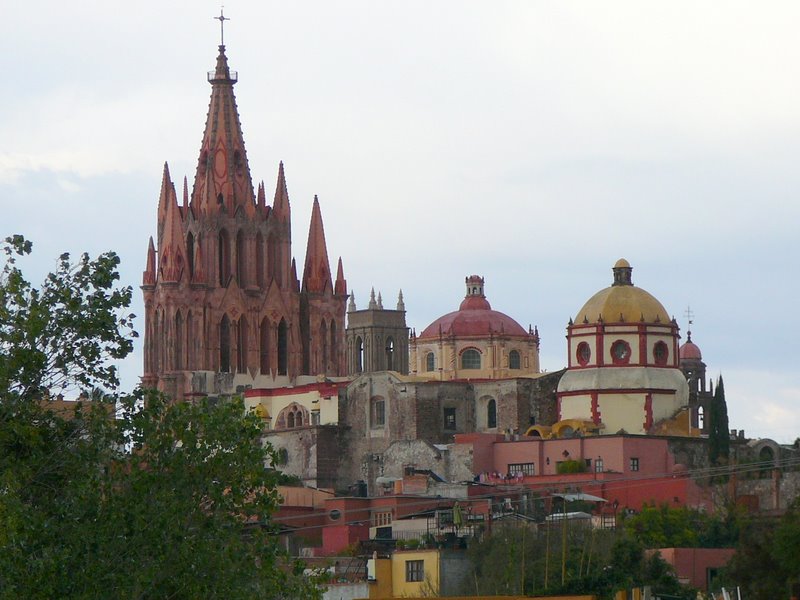
attention and tourist visits.
Parroquia just means it's the town's parish
church; officially it's La Parroquia de San Miguel (Saint
Michael). (Not being the seat of a diocese, San
Miguel does not merit a cathedral. It does claim the
birthplace of the first native-born Mexican to become a
bishop and this bishop commissioned the much discussed
Gothic facade. More details on that on our
Parroquia
page.)
Like a lot of the great European cathedrals, La Parroquia
is an example of so many architects, so much time.
Fashions change (or were invented) while the place
was being built or remodeled over two centuries.
Three architects separately made quite distinct
contributions to La Parroquia starting with Marco Antonio
Sobrarias who laid out the place in the traditional Latin
cross
[219]
like any good parish
church in 1683. Next the crypt was added below the
main altar by a local (but quite rightfully famous)
architect/sculptor/muralist named
Francisco Eduardo Tresguerras. Finally
the pièce de résistance (much
résisted by some architectural purists), the
Gothesque pink tower, was added in the 1880s by San Miguel
native Ceferino Gutierrez
[219]
. (To see and
read a lot more about the inside and outside of La
Parroquia,
click here.)
Next to La Parroquia rises another church dedicated to the
archangel Rafael.
Click here to
see photos.
The Churrigueresque/Neo-classical San Francisco
La Parroquia anchors the south of the town's central square
called La Jardin. A block east of La
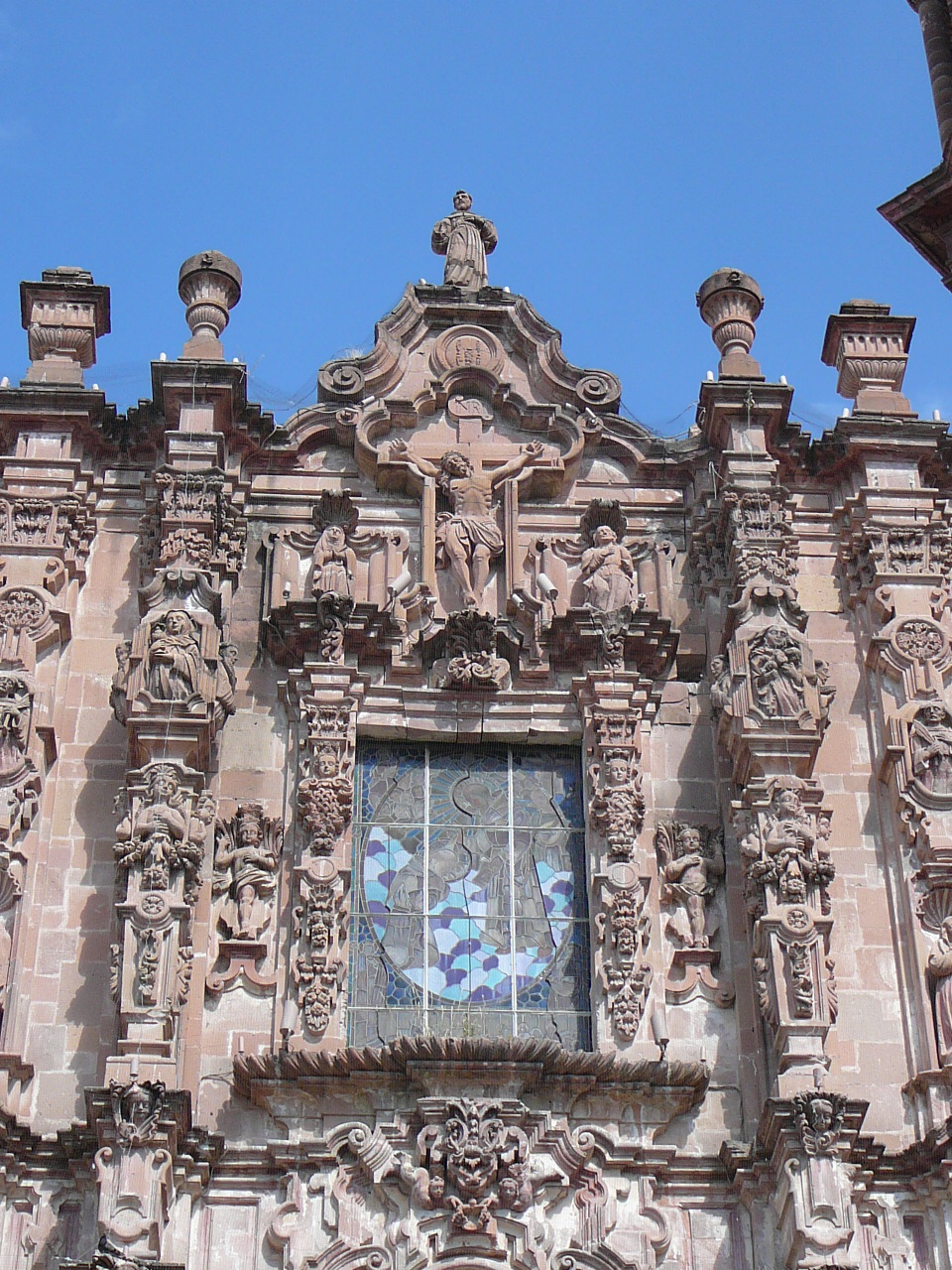
Jardin rises a much different church also
modified (perhaps even rescued) by architect
Tresguerras: San
Francisco.
At right notice the elaborate Spanish Rococo ornamentation
called Churrigueresque. Silver money funded
ostentatious religious displays such as this as the wealthy
tried to one-up their peers in neighboring towns.
Unfortunately, in the 20 years it took to build this
church, the style faded in the official admiration of
Mexico city and Madrid bureaucrats and they outlawed
further use before the steeple could be finished.
This led Tresguerras to add an elegant but restrained
neo-classical tower to the right of this elaborate
facade.
Tresguerras continued this restraint inside, making San
Francisco one of the most upscale churches in town--and a
frequent wedding venue.
Click
here to study the Church of San Francisco both inside
and out.
The sixteen-year-old who created Las Monjas
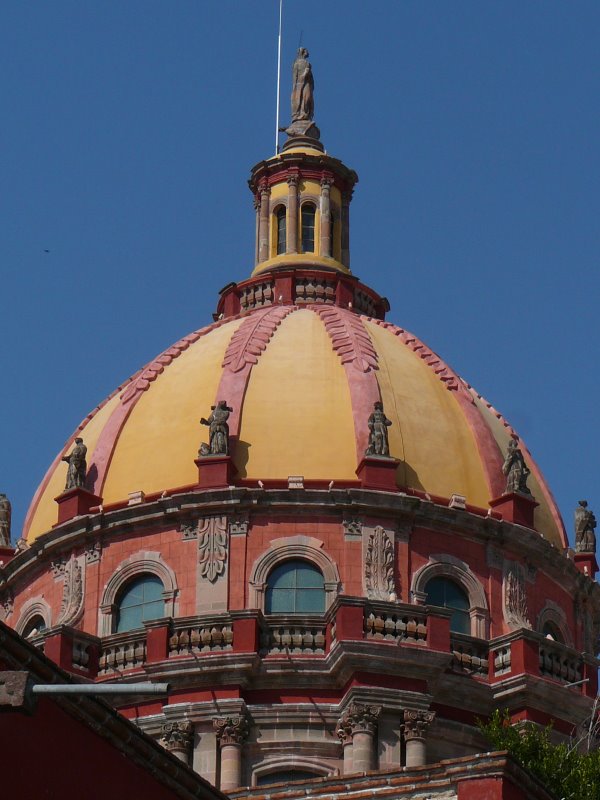
Just to the west of the town's
main square rises an impressive twelve-sided dome modeled
after that of the Parisian Chapel of
Les Invalides designed by one of history's
best known architects. In fact, this derivative dome
is the work of Ceferino Gutierrez -- yes, the same
unschooled designer of the neo-Gothic tower on La
Parroquia!
The church was part of a large expanse of convent land
donated by the 16 year old daughter of the town's
wealthiest family. Her parents died and she took her
inheritance and built a convent to hold 72 nuns, most of
them cloistered.
She had to start her own order in 1754 as there were no
convents within 100 miles of San Miguel then. She
dedicated the order and the convent to the Immaculate
Conception. Today everyone calls this church Los
Monjas which means "the nuns." A few cloistered
sister remain today to tend to the church. See their
picture and learn much more by
clicking
here.
Oratorio and Santa Casa Loreto
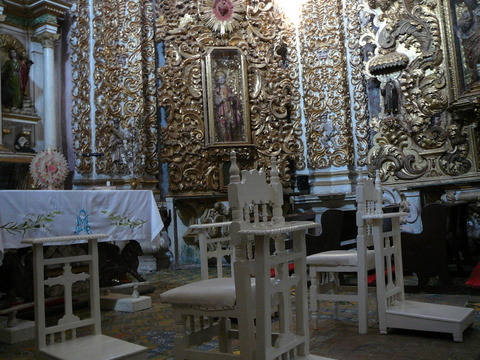
The town's second square features a
utilitarian square filled with markets and lined at the
north end by several churches. Prime among these is
the Oratorio, a house of preaching, built by extending a
much simpler church built by mulattoes descended from West
Indian/African slaves.
Around the same sheltered garden is the town's most lavish
religious interior: the Santa Casa Loreto, replica of
the Nazareth home of first Mary and then Jesus. Built
to entomb San Miguel's wealthiest patrons, it features an
octagonal camarin bristling with gold and ceramics.
Click here to
visit.
La Salud and the Colegio
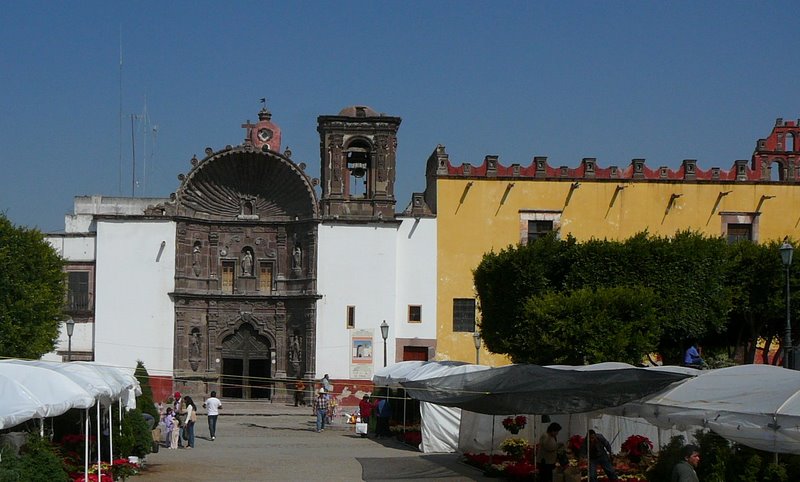
Just east of the Oratorio is a smaller church: the Temple
of Our Lady of Health,
La
Salud. In fact, it was built as the chapel for
the former college of St. Francis de Sales, the earth-toned
building next door. While this was once a large swath
of church land, it has been appropriated for a cement
square now called Allende Plaza or Plaza Civico.
Unlike the upscale Jardin nearby, it teems with
merchant tents. To learn more about this chapel, its
college, and the two revolutionaries who gave their name to
this and a nearby town,
click here.
The mystical Santuario de Atotonilco
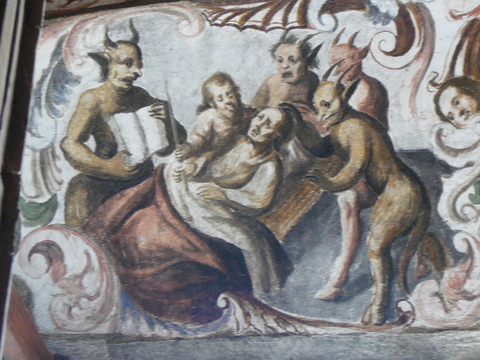
About 9 miles north of town, the
ascetic Luis Felipe Neri de Alfaro, who gave his
fortune to build La Salud (pictured above), relied on the
kindness of strangers (and according to one of his
accounts, at least one angel) to fund what is today still a
retreat center for the devout (and coincidentally a folk
art jewel for tourists.) At left above is just one of
the numerous murals that line almost every nook and cranny
of the Santuario de Atotonilco. The artist was Miguel
Antonio Martinez Posasangre who created a folk-art graphic
novel on the walls. Its text was done by none other
than Father Alfaro. In the picture above, devils
snatch the soul of a dying man and escort him to eternal
damnation. Hoping to avoid a similar conclusion to
their lives, about 75,000 pilgrims still venture here each
year with whips and crowns of thorns; they stay a
week and make a week-long retreat.
Click here for a shorter and,
hopefully, less painful visit.
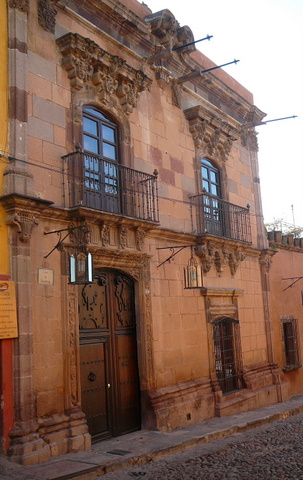
And now for one last "religious" site in
this town of hundreds of churches. At right is the
1780 Inquisitor's House with its ornate combination of
French and Spanish baroque facade including the stone
"curtains" and what look to be ski poles bristling from the
roof line. While this building still dominates Calle
Cuadrante, it originally had land attached to it that
covered half the block. Click on the picture to see
it enlarged (click again to zoom in); when you do, you'll
see some funny looking grape bunches. This was
because its native Mexican stone carvers had never seen
grapes! The Spanish crown forbade their cultivation
here.
[73]
Monopoly!
Established in 1571, the Mexican Inquisition was still active when the Mexican War
of Independence started near here in 1810. That war
effectively ended the Inquisition in most of Mexico since
the Spanish Inquisition, begun in 1478 by Ferdinand
and Isabella -- also sponsors of a Florentine sailor
named Columbus -- was always run under the Spanish
king's authority, not that of the Pope. Obviously traces of
this perilous institution survived even the war: The
last auto-da-fé, the Inquisition's public
sentencing ceremony typically held in the town plaza, was
in Mexico as late as
1850!
The Mexican Inquisition was a little more kindler and
gentler than its parent; it went after mostly Protestants
and Jews (who were forbidden to emigrate to the Americas
until the fourth generation after conversion; but many of
them --as early as Columbus's day -- were smuggled in and
lived in
toleration
with their Catholic neighbors throughout the colonies.) From the
beginning, the Inquisition ignored the native peoples who were thought
to be too new of converts to treat as
heretics. After 1665, the Catholic
hierarchy began to fear the Protestants as a greater threat
than the Jews and shifted their inquisitorial efforts
accordingly.
Green Places
We have already discussed the Allende or Civic Plaza
already, now let's highlight two other public (and
much greener) spaces.
The Jardin: the relaxed heart of San Miguel
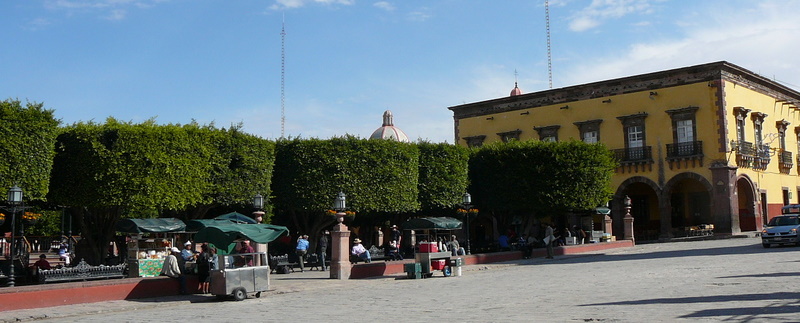
It is impossible to think of San Miguel de Allende without
picturing the iconic La Parroquia tower as seen
through the dark green Laurel trees of the central square
which everyone calls the Jardin. This picturesque
rectangle is lined on three sides with the residences of
San Miguel's 18th century elite including that of the rebel
Ignacio Allende and his conservative resisters, the storied
De la Canal family. Visit the Jardin and its
surroundings by
clicking
here.
Where the natives play: Juarez park
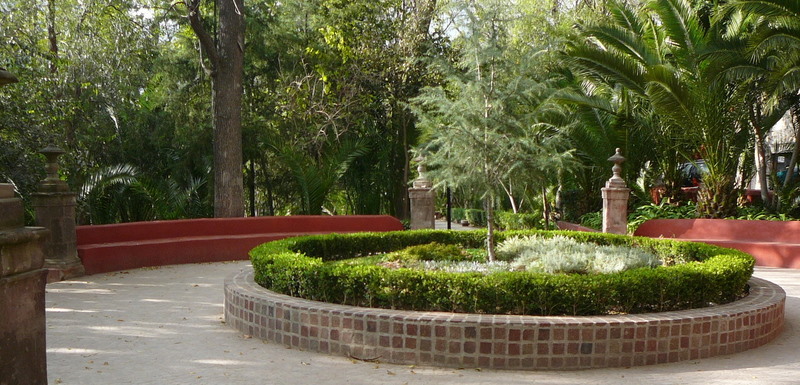
Probably every tourist walks through the central
Jardin, but there is a much larger park about a half-mile
to the South used by the locals for recreation. To
see more of Parque Juarez,
click here.
Early (and late) Urban Renewal: The Chorro Area
Shortly after Founding Father Juan de San Miguel moved on
to more fertile missionary fields, his Franciscan
assistant, Bernardo Cossin, moved the town center up the
Hill of Moctezuma in order to find a more reliable water
supply near the town spring. (A better missionary
than town planner, Juan de San Miguel had originally
located the settlement at the edge of a river that often
ran dry.)
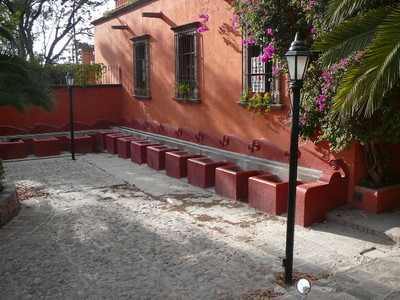
The
Laundry in the Charro Area nicknamed the San Miguel
Laundromat[81]
|
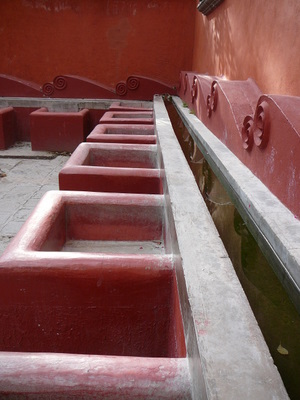
|
See more panoramic photos from the Charro and the Mirador
by clicking
here.
Culture
Guanajuato is a very Catholic state in a very Catholic
country (despite the long opposition of the federal
government.) But while the indigenous folk have their
devotions, the expats have their newer religion: the arts.
Nearly every block in the historic Centro area sports
a gallery or two, interspersed with those other temples
devoted to cuisine. Annual performing arts festivals
for tourists rival Holy Week activities for the
natives.
We've already seen the Casa de la Cultura in the
old Waterworks building which houses Ballet
Folklorico de San Miguel. Now let's turn our
attention to two institutions that helped San Miguel
de Allende attain its prominent position in the art
world:
The art engine that became the Instituto
Allende
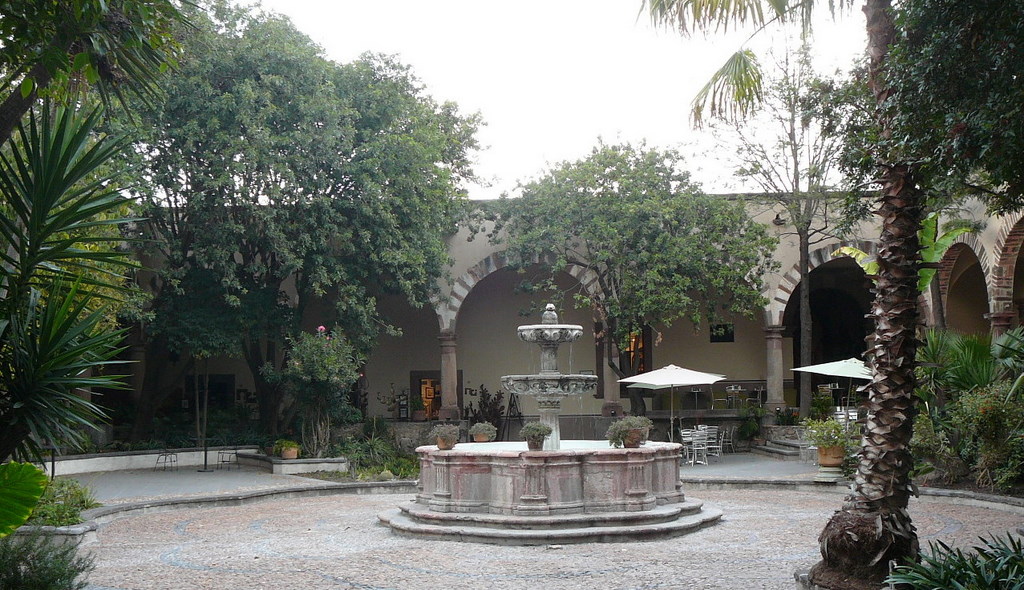
The 1926 designation of San Miguel de Allende as a
historical (and hence unmodifiable) site preserved the
architecture of the Spanish colonialists. But it was
the art school started in 1937 that provided the economic
resurgence of this sleepy town. GI Bill benefits and
low, low, prices made this a popular place for turning
soldiers into artists. Some stayed and turned the
town into an art colony. See more by
clicking
here.
"El Nigromante" home of the Bellas Artes.
Next to the twelve-sided dome of the Church of the
Immaculate Conception (Las
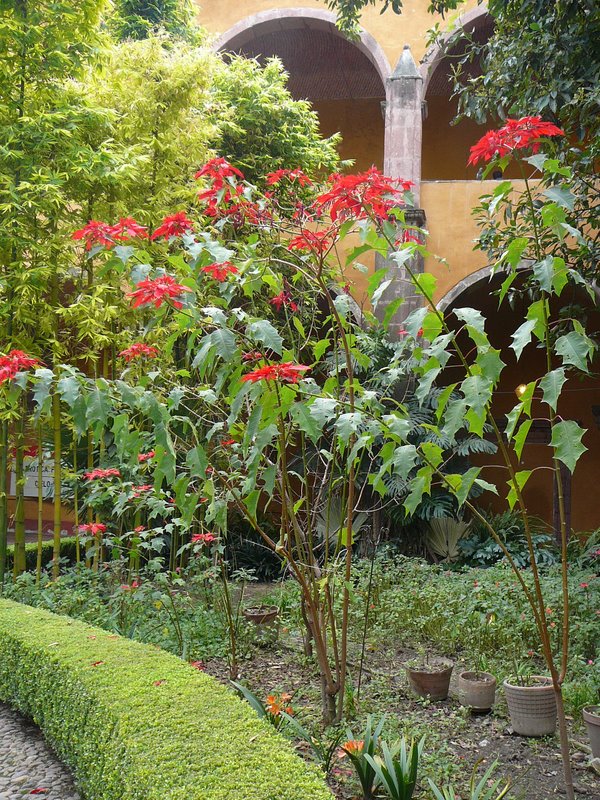
Monjas--the Nuns) is the
former cloister of the nunnery -- long since "liberated" by
the federal government. Today it is a lush garden and
thriving art center named after San Miguel's most famous
literary son who called himself "the Magician (El
Nigromante)" Without a psuedoname, Ignacio Ramirez
would have been arrested early and often.
During the 1860s, most Church property was confiscated
except for the actual insides of the churches themselves.
This makes for some ironic juxtapositions of objects
and their spaces. Here we have a lushly landscaped
religious cloister centered around a fountain with the
traditional lamb-of-god statue. Upon entrance, we are
confronted by a bronze honoring one of the earliest
Mexican atheists (Ignacio Ramirez). At the back of
the complex we find a room filled with murals of a
well known (and twice exiled) Stalinist, David Alfaro
Siqueiros. To visit,
click
here.
The Nigromonte Center bustles with arts activity almost
every night. Another performing arts building rises
nearby, anchoring several restaurants. It's the
Teatro Angela Peralta.
Built as an opera house in 1973, this building was named
after the most famous Mexican opera singer of the day,
Angela Peralta. Called the "Mexican Nightingale," she
debuted at Milan's La Scala at age 17 -- but died at age
36. The building survived and got a facelift
[87]
with the pink 1915 facade seen in the pictures above
left. The photo to the right shows the theater's
gallery-filled street which stretches east towards the
distant dome of the church of San Francisco. This facade was by
Antonio Sierra, another mason and self-taught architect
like Ceferino Gutierrez who had built the pink facade on La
Parroquia
35 years before. The building was restored recently
after being (ab)used as a movie theater.
Venture to nearby Dolores Hidalgo, another important town in the Mexican War of Independence, by clicking here.
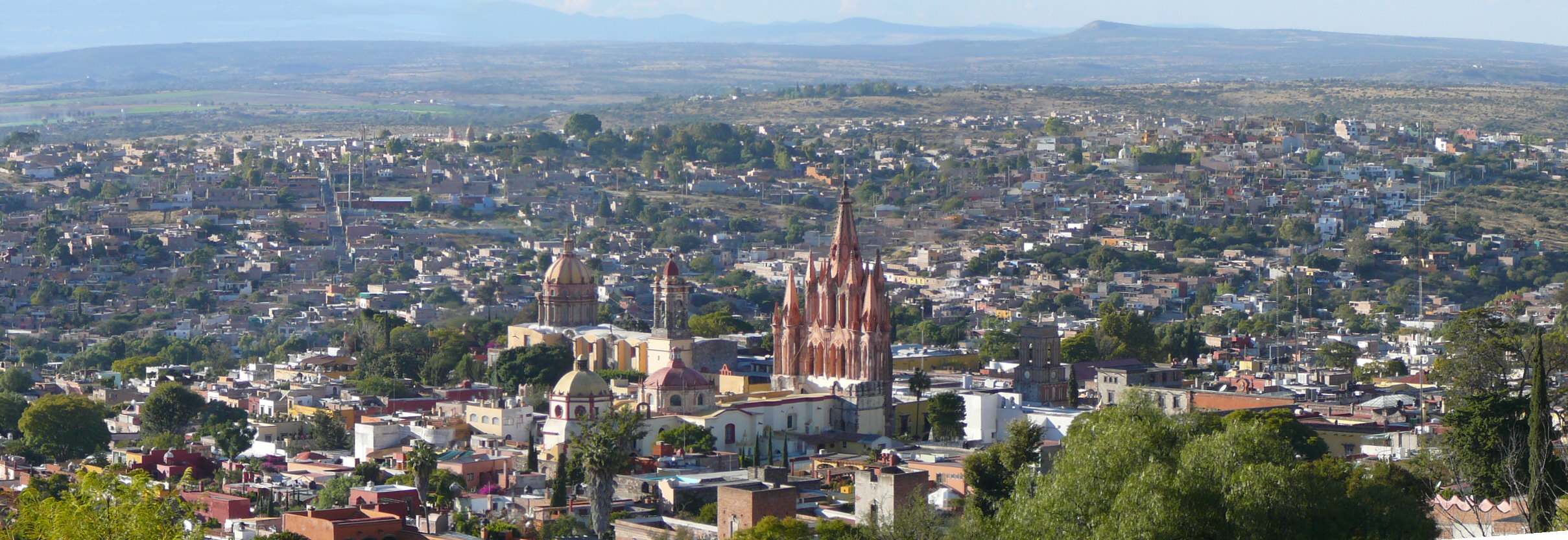
 attention and tourist visits.
Parroquia just means it's the town's parish
church; officially it's La Parroquia de San Miguel (Saint
Michael). (Not being the seat of a diocese, San
Miguel does not merit a cathedral. It does claim the
birthplace of the first native-born Mexican to become a
bishop and this bishop commissioned the much discussed
Gothic facade. More details on that on our Parroquia
page.)
attention and tourist visits.
Parroquia just means it's the town's parish
church; officially it's La Parroquia de San Miguel (Saint
Michael). (Not being the seat of a diocese, San
Miguel does not merit a cathedral. It does claim the
birthplace of the first native-born Mexican to become a
bishop and this bishop commissioned the much discussed
Gothic facade. More details on that on our Parroquia
page.)